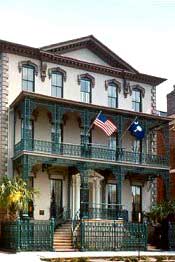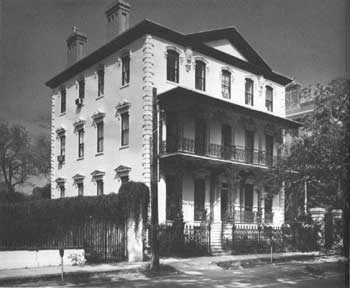







Survey of
Historic Sites and Buildings
 |
GOVERNOR JOHN RUTLEDGE HOUSE South Carolina |
 Governor John Rutledge House |
| ||
John Rutledge built this house in 1763 and resided in it from the time of his marriage until his death in 1800. These years spanned his public career.
Originally the large, brick residence rose two stories over an elevated basement. Thomas M. Gadsden added the third floor in 1853. The five-bay house is in excellent condition. Elaborate inside end chimneys stand at each side of the slate-covered roof. A three bay pediment at the roofline and an elaborate two-story cast- and wrought-iron porch embellish the front, or south, elevation. The corners of the house are marked by quoins, and the windows are topped by triangular pediments on the first floor, broken pediments on the second, and segmentally arched-hood molding on the third. Pilasters, a triangular pediment, and a transom accent the central front entrance. A dentiled cornice spans the roofline and the pediment.
 |
| Governor John Rutledge House. (National Park Service (Contractor Louis Schwartz, 1975).) |
A central hall, which contains the stairs near the rear, extends through the house and divides the first-floor rooms into pairs. On the second floor, a bedroom is on either side of the short central hall, which is at the rear. The entire front half of that level is occupied by two large rooms, once a drawing room and a library, that could be combined to form a large ballroom. The third floor contains four chambers.
The parquet flooring of the first and second stories is original. The eight marble mantels on these floors probably date from the mid-19th century. Partitions and false ceilings have been installed, but no significant structural alterations have been made. In the 1970s, law offices occupied the building. It has subsequently been converted to an Inn accommodating overnight guests. Next door is the residence of Edward Rutledge, John's brother, who was a signer of the Declaration of Independence. That house, too, is a National Historic Landmark.
 |
 |
http://www.cr.nps.gov/history/online_books/constitution/site24.htm
Last Updated: 29-Jul-2004